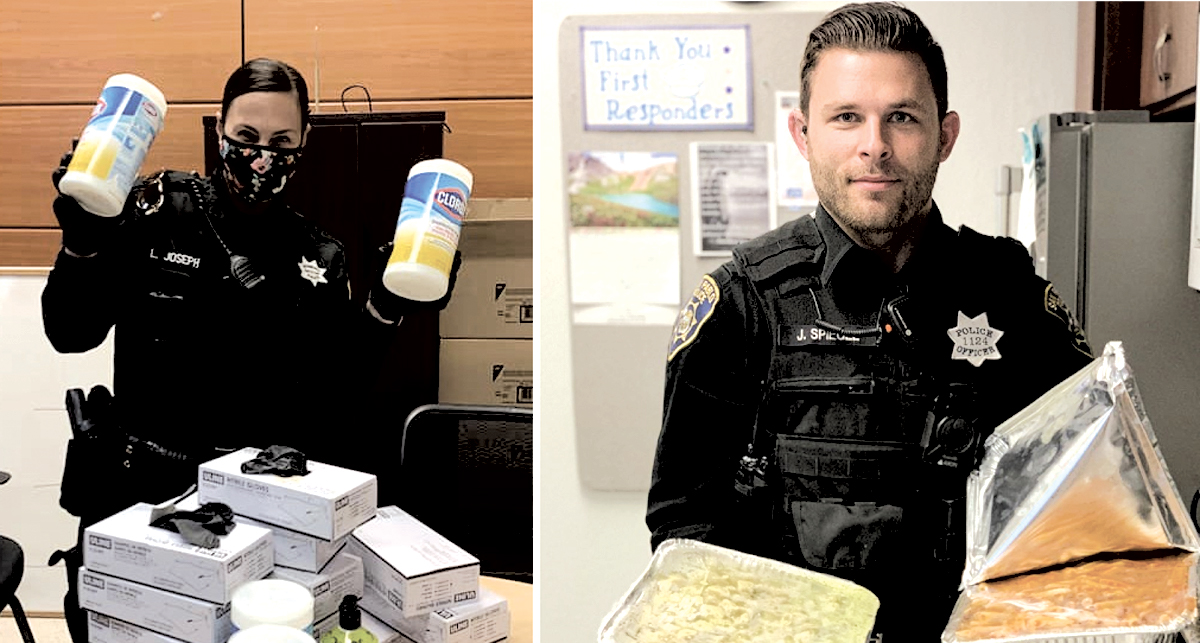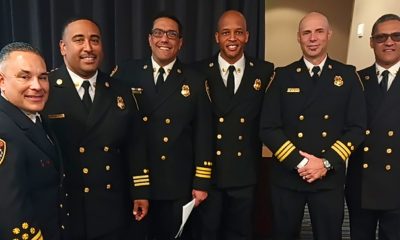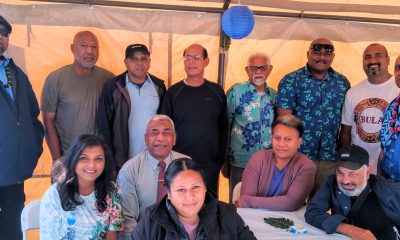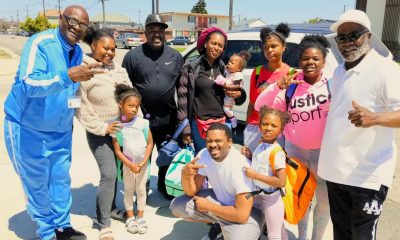Bay Area
Small Business Owners Step Up for First Responders

After a nurse-friend who works at Kaiser Vacaville shared the difficulties of serving on the COVID-19 front lines, Jennifer Arrouzet, who co-owns Café Soleil in El Sobrante with her husband Todd, worked her community contacts to round up hundreds of Clorox wipes and sanitizer spray bottles to donate to nurses at the medical center.
She didn’t stop there. She secured 5,000 N-95 masks and 20,000 gloves purchased for donation by a former neighbor, Tom Bolling, who knew Jennifer would find a good place for them.
The San Pablo Police Department picked up 1,000 masks, leaving with the promise that they’d share them with the Richmond Police Department, Contra Costa County Sheriff’s Department, San Pablo Fire Department and El Sobrante Fire Department—which they did.
Another 3,000 masks will be dispersed by Jennifer’s business to Kaiser Vacaville and Kaiser Richmond today via her nurse-friend. She’s saving the remaining 1,000 masks to give to any other first responders who need them in an emergency situation and donated the gloves to local police and Kaiser Vacaville.
Despite the COVID-19 pandemic, local small businesses that are facing an uncertain future are still finding creative ways to support first responders.
San Pablo police and city officials have received donations of food and additional personal protective equipment from local businesses such as Maya Thai Laos Restaurant, La Strada Restaurant, FoodMaxx, and Krispy Krunchy Chicken, said San Pablo police Capt. Brian Bubar. Bubar thanked the San Pablo EDC for providing support and connections for both small businesses and first responders.
This week, Abraham Alex, owner of Krispy Krunchy Chicken in Pinole, began delivering chicken to police, calling law enforcement “the backbone that keeps it all together.
“We in business must do our part for them,” he said, adding that his business is also looking to donate to individuals and families in need.
In turn, police are doing their part to support local businesses. Last week, a San Pablo police sergeant bought 13 members of his team lunch at La Strada on Church Lane, which is offering takeout during the pandemic. The gesture deeply touched the Italian restaurant’s 24-year owner, Martin Gonzalez.
Right then, Gonzalez decided to offer 20 percent discounts for all first responders.
“Everybody is struggling here, we are all in the boat,” Gonzales said. “There are no words to express having the support of the San Pablo Police Department to help keep our doors open.”
All in the same boat indeed. Small business owners and their staff are enduring an uncertain future after having to close their doors due to the COVID-19 lockdown. Many restaurants are relying solely on takeout or delivery or simply shutting down for the time being.
At the start of the shelter-in-place order, however, small business owners like Jennifer and Todd Arrouzet appeared more worried about their staff and the community than their personal survival.
“I just saw a need, and it was desperate, and I acted,” Jennifer said, noting that she didn’t think anybody was prepared for the pandemic. “It’s so heartbreaking to see any first responder have to go through this. They can’t say, ‘no, I’m not coming in,’ and they’re human, just like us. That’s my drive.”
In addition to the donations of supplies to first responders, Jennifer created “Essential Packages” that customers can purchase for $40 from Café Soleil at 3550 San Pablo Dam Rd. The packages, which can be used by the purchaser or donated, include three pounds of chicken, one dozen eggs, one gallon of milk, one loaf of bread, one pound of flour/risotto/sugar, three pounds of red potatoes and one sanitizer spray bottle (while supplies last). The packages can be picked up or delivered.
“My attitude from day one of this virus has been that if we can’t be at our best during the worst of times, what’s the point? We need to be kind. Everybody is suffering and I feel that. I’m just trying to set an example…If anyone is suffering or in need, call me,” said Jennifer.
“I’ve always believed that if you take care of your community and your people, you don’t need to worry about the rest. It will be ok,” she added.
Capt. Bubar echoed the sentiment.
“We are thankful of the words of encouragement we’ve received within the community and our social media platforms,” the captain said. “As first responders, our staff understands the responsibility to come to work every day and face this challenge head-on. As difficult as this can be, we are here knowing our community recognizes and appreciates that challenge. We will get through this together.”
Activism
Oakland Post: Week of December 10 – 16, 2025
The printed Weekly Edition of the Oakland Post: Week of – December 10 – 16, 2025

To enlarge your view of this issue, use the slider, magnifying glass icon or full page icon in the lower right corner of the browser window.
Alameda County
Seth Curry Makes Impressive Debut with the Golden State Warriors
Seth looked comfortable in his new uniform, seamlessly fitting into the Warriors’ offensive and defensive system. He finished the night with an impressive 14 points, becoming one of the team’s top scorers for the game. Seth’s points came in a variety of ways – floaters, spot-up three-pointers, mid-range jumpers, and a handful of aggressive drives that kept the Oklahoma City Thunder defense on its heels.

By Y’Anad Burrell
Tuesday night was anything but ordinary for fans in San Francisco as Seth Curry made his highly anticipated debut as a new member of the Golden State Warriors. Seth didn’t disappoint, delivering a performance that not only showcased his scoring ability but also demonstrated his added value to the team.
At 35, the 12-year NBA veteran on Monday signed a contract to play with the Warriors for the rest of the season.
Seth looked comfortable in his new uniform, seamlessly fitting into the Warriors’ offensive and defensive system. He finished the night with an impressive 14 points, becoming one of the team’s top scorers for the game. Seth’s points came in a variety of ways – floaters, spot-up three-pointers, mid-range jumpers, and a handful of aggressive drives that kept the Oklahoma City Thunder defense on its heels.
One of the most memorable moments of the evening came before Seth even scored his first points. As he checked into the game, the Chase Center erupted into applause, with fans rising to their feet to give the newest Warrior a standing ovation.
The crowd’s reaction was a testament not only to Seth’s reputation as a sharpshooter but also to the excitement he brings to the Warriors. It was clear that fans quickly embraced Seth as one of their own, eager to see what he could bring to the team’s championship aspirations.
Warriors’ superstar Steph Curry – Seth’s brother – did not play due to an injury. One could only imagine what it would be like if the Curry brothers were on the court together. Magic in the making.
Seth’s debut proved to be a turning point for the Warriors. Not only did he contribute on the scoreboard, but he also brought a sense of confidence and composure to the floor.
While their loss last night, OKC 124 – GSW 112, Seth’s impact was a game-changer and there’s more yet to come. Beyond statistics, it was clear that Seth’s presence elevated the team’s performance, giving the Warriors a new force as they look to make a deep playoff run.
Activism
Oakland Post: Week of November 26 – December 2, 2025
The printed Weekly Edition of the Oakland Post: Week of November 26 – December 2, 2025

To enlarge your view of this issue, use the slider, magnifying glass icon or full page icon in the lower right corner of the browser window.
-

 Activism4 weeks ago
Activism4 weeks agoOakland Post: Week of November 12 – 18, 2025
-

 Activism3 weeks ago
Activism3 weeks agoIN MEMORIAM: William ‘Bill’ Patterson, 94
-

 Activism4 weeks ago
Activism4 weeks agoHow Charles R. Drew University Navigated More Than $20 Million in Fed Cuts – Still Prioritizing Students and Community Health
-

 Bay Area4 weeks ago
Bay Area4 weeks agoNo Justice in the Justice System
-

 #NNPA BlackPress3 weeks ago
#NNPA BlackPress3 weeks agoBeyoncé and Jay-Z make rare public appearance with Lewis Hamilton at Las Vegas Grand Prix
-

 #NNPA BlackPress3 weeks ago
#NNPA BlackPress3 weeks agoLewis Hamilton set to start LAST in Saturday Night’s Las Vegas Grand Prix
-

 Activism3 weeks ago
Activism3 weeks agoOakland Post: Week of November 19 – 25, 2025
-

 #NNPA BlackPress4 weeks ago
#NNPA BlackPress4 weeks agoThe Perfumed Hand of Hypocrisy: Trump Hosted Former Terror Suspect While America Condemns a Muslim Mayor
















































